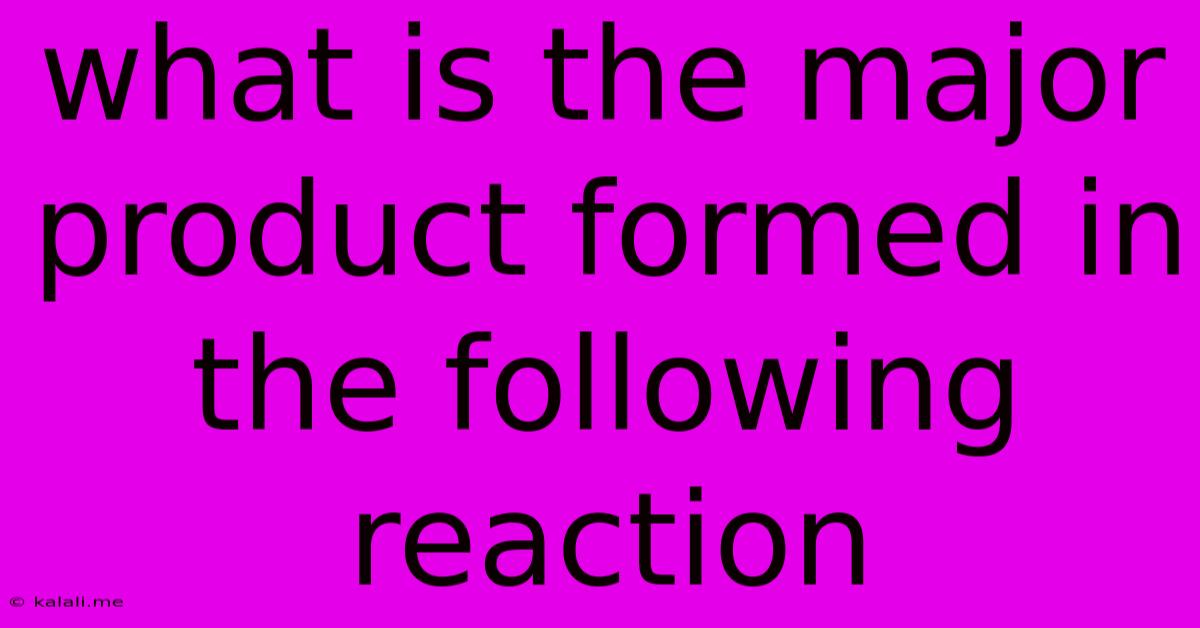What Is The Major Product Formed In The Following Reaction
Kalali
Jun 12, 2025 · 3 min read

Table of Contents
What is the Major Product Formed in the Following Reaction? A Guide to Predicting Organic Reaction Outcomes
This article explores how to predict the major product formed in organic reactions. Understanding reaction mechanisms and applying key principles is crucial for accurately predicting the outcome. This will cover various reaction types, including SN1, SN2, E1, and E2 reactions, and factors influencing product formation like substrate structure, nucleophile/base strength, and solvent effects. This detailed guide will help you master predicting organic reaction outcomes.
Understanding Reaction Mechanisms: The Key to Prediction
Before diving into specific examples, it’s essential to understand the underlying mechanisms of common organic reactions. These mechanisms dictate the pathway of the reaction and ultimately determine the major product formed. The most common mechanisms include:
- SN1 (Substitution Nucleophilic Unimolecular): A two-step process involving carbocation formation as an intermediate. Favored by tertiary substrates, polar protic solvents, and weak nucleophiles.
- SN2 (Substitution Nucleophilic Bimolecular): A one-step concerted mechanism. Favored by primary substrates, strong nucleophiles, and polar aprotic solvents.
- E1 (Elimination Unimolecular): A two-step process involving carbocation formation, leading to alkene formation. Favored by tertiary substrates, polar protic solvents, and high temperatures.
- E2 (Elimination Bimolecular): A one-step concerted mechanism leading to alkene formation. Favored by strong bases, and often secondary or primary substrates.
Factors Influencing Product Formation
Several factors influence which product will be the major one in a given reaction:
- Substrate Structure: The structure of the starting material significantly impacts the reaction pathway. Tertiary substrates generally favor SN1 and E1 reactions due to carbocation stability. Primary substrates favor SN2 and E2 reactions. Secondary substrates can undergo both SN1/SN2 and E1/E2, depending on reaction conditions.
- Nucleophile/Base Strength: Strong nucleophiles favor SN2 reactions, while weak nucleophiles can lead to SN1 reactions. Similarly, strong bases favor E2 reactions, while weaker bases might favor E1 reactions under specific conditions.
- Solvent Effects: Polar protic solvents stabilize carbocations, favoring SN1 and E1 reactions. Polar aprotic solvents stabilize anions, favoring SN2 reactions. The solvent's polarity plays a critical role in determining reaction rates and selectivity.
- Steric Hindrance: Bulky substituents can hinder the approach of nucleophiles or bases, influencing reaction rates and product distribution. This is particularly relevant in SN2 and E2 reactions.
- Temperature: Higher temperatures generally favor elimination reactions (E1 and E2) over substitution reactions.
Predicting the Major Product: A Step-by-Step Approach
To predict the major product, consider the following steps:
- Identify the reaction type: Is it a substitution (SN1 or SN2) or elimination (E1 or E2) reaction?
- Analyze the substrate: Is it primary, secondary, or tertiary? What are the substituents?
- Evaluate the nucleophile/base: Is it strong or weak? Is it bulky?
- Consider the solvent: Is it polar protic or polar aprotic?
- Assess reaction conditions: What is the temperature?
By systematically evaluating these factors, you can accurately predict the most likely major product of the organic reaction.
Examples and Practice Problems
While providing specific examples without a defined reaction is impossible, the principles outlined above can be applied to any given reaction. Practice problems are essential for mastering this skill. Focus on understanding the underlying mechanisms and applying the principles discussed. Work through examples in textbooks or online resources to build confidence and proficiency.
Conclusion:
Predicting the major product formed in an organic reaction requires a deep understanding of reaction mechanisms and the various factors that influence reaction pathways. By carefully analyzing the substrate, nucleophile/base, solvent, and reaction conditions, you can develop the skills necessary to successfully predict the outcome of many organic reactions. Consistent practice and a thorough grasp of the underlying principles are key to mastering this important aspect of organic chemistry.
Latest Posts
Latest Posts
-
Which Of The Following Is Not An Enzyme
Jun 13, 2025
-
Difference Between Lok Sabha And Vidhan Sabha
Jun 13, 2025
-
Which Hemisphere Is India Located In
Jun 13, 2025
-
Which Of The Following Will Not Show Tyndall Effect
Jun 13, 2025
-
Electric Field Due To Infinite Line Charge
Jun 13, 2025
Related Post
Thank you for visiting our website which covers about What Is The Major Product Formed In The Following Reaction . We hope the information provided has been useful to you. Feel free to contact us if you have any questions or need further assistance. See you next time and don't miss to bookmark.